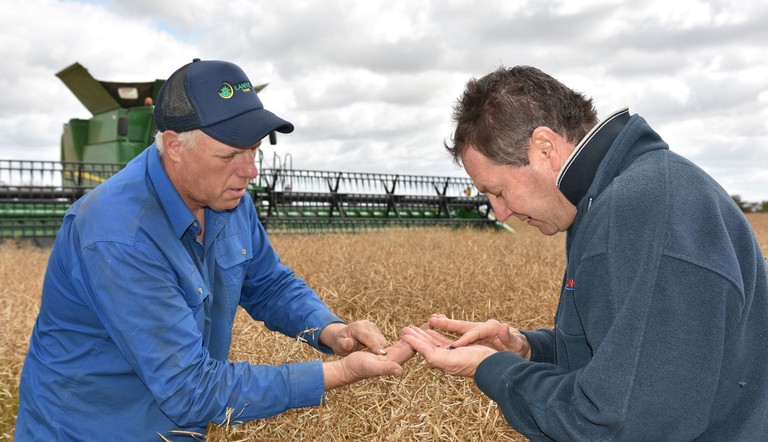
VIC growers improving weed control in canola phase

Ryegrass was particularly resistant to glyphosate and had been a major problem, while some wild oat populations were resistant to FOP herbicides.
James Murray, Agronomist in the region with IK Caldwell at Cobram, said growers traditionally applied trifluralin and triallate against ryegrass and wild oats in canola and more recently used mixes like propyzamide and trifluralin, however Tenet® herbicide was now providing a new option with strong benefits.
Containing the active ingredient, metazachlor, Tenet is the only Group 15 herbicide that can be applied pre-emergent or post-emergent in canola. Developed by ADAMA Australia, it has the broadest weed control spectrum, providing residual control or suppression of more than 20 annual grass and broadleaf weeds, also including barley grass, brome grass and capeweed.
James said Tenet washed-off stubbles well and compared with propyzamide, it was far more mobile and highly soluble, which was important considering autumn rains can be limiting through the region. “That’s what gives it the edge. There’s a lot to like about it. It can be used IBS (incorporated by sowing), but it also has the flexibility that if you haven’t used it upfront and you have some weed escapes, it can be used as an early post-emergent treatment.’’
“As long as it is tank-mixed with something IBS, it provides high level control of annual ryegrass and is quite superior on wild oats. It also has been very good on hogweed, milk thistle and wet weeds, particularly toad rush. Usually, we will get third and fourth germinations of ryegrass and Tenet has been important in reducing numbers leading into the next wheat crop.’’
Katamatite grower Jarrod Lukies said herbicide-resistant annual ryegrass and wild oats were becoming more prevalent on the family’s ‘Lanivet Farms’ property and they were strongly targeting them during the canola phase of their cropping program. The Lukies grow conventional and herbicide-tolerant canola varieties, including for seed production, and they are included in continuous rotations with wheat and barley winter crops, as well as with summer crops of corn.
Jarrod said previously for their canola, they applied trifluralin and triallate pre-emergent herbicides, followed by an in-crop treatment with clethodim and then application of glyphosate later in the season to help prevent grass seedset. Last year, there also was a shortage of propyzamide and this prompted a re-think for their pre-emergent applications. They took advantage of an opportunity to “double knock’’ with paraquat, followed by a pre-emergent application of trifluralin and triallate herbicides, and then added the Tenet herbicide to post-emergent applications of clethodim.
“We noticed quite a few escapes post-emergent, so we went with 750 millilitres per hectare of Tenet with the clethodim and we found that it did a really good job of cleaning up those small, in-furrow grasses. It was really quite good and we will adopt it as practice,’’ Jarrod said. “We are getting some clethodim resistance, so with Tenet, it will clean up the escapes that the clethodim is not getting.
“It also stopped a lot of the wet weeds that otherwise would not have been controlled and the results spoke for themselves – the paddocks were quite clean after the applications.
“Tenet is a new tool and hopefully it will also add to the longevity of some existing chemicals we use.’’ He said they liked the fact it could be applied pre-emergent or post-emergent and it mixed and carried well with other herbicides.
The Lukies applied Tenet via their Patriot sprayer, which features a pulse width modulation spraying system. They generally aim for a medium droplet spectrum. “It was stable and good to handle in the mix, and there were no effects on the crop,’’ Jarrod said.
He expected Tenet would become “a key tool in the toolbox’’ for their cropping program, whether applied pre-emergent or post-emergent, to help limit weed resistance and also extend the use of other herbicides. “We will do paddock plans and look to address those issues and apply what is best for our cropping system.’’
James said the industry would be careful to ensure correct stewardship with the new herbicide. “We want to preserve Group 15s for as long as we can. We want to ensure we don’t break the product,’’ he said.
“Tenet is a product to use strategically. If we have got high (grass weed) numbers, we need to be doing everything we can to reduce those numbers.’’
